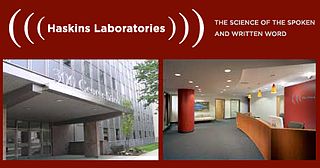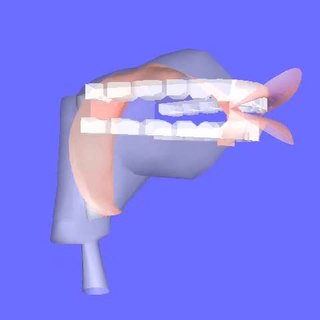
The voiced alveolar approximant is a type of consonantal sound used in some spoken languages. The symbol in the International Phonetic Alphabet that represents the alveolar and postalveolar approximants is ⟨ɹ⟩, a lowercase letter r rotated 180 degrees. The equivalent X-SAMPA symbol is r\.
Articulation may refer to:

In phonetics, voice onset time (VOT) is a feature of the production of stop consonants. It is defined as the length of time that passes between the release of a stop consonant and the onset of voicing, the vibration of the vocal folds, or, according to other authors, periodicity. Some authors allow negative values to mark voicing that begins during the period of articulatory closure for the consonant and continues in the release, for those unaspirated voiced stops in which there is no voicing present at the instant of articulatory closure.
A stop with no audible release, also known as an unreleased stop or an applosive, is a stop consonant with no release burst: no audible indication of the end of its occlusion (hold). In the International Phonetic Alphabet, lack of an audible release is denoted with an upper-right corner diacritic after the consonant letter, as in:, ,.

Haskins Laboratories, Inc. is an independent 501(c) non-profit corporation, founded in 1935 and located in New Haven, Connecticut, since 1970. Haskins has formal affiliation agreements with both Yale University and the University of Connecticut; it remains fully independent, administratively and financially, of both Yale and UConn. Haskins is a multidisciplinary and international community of researchers that conducts basic research on spoken and written language. A guiding perspective of their research is to view speech and language as emerging from biological processes, including those of adaptation, response to stimuli, and conspecific interaction. Haskins Laboratories has a long history of technological and theoretical innovation, from creating systems of rules for speech synthesis and development of an early working prototype of a reading machine for the blind to developing the landmark concept of phonemic awareness as the critical preparation for learning to read an alphabetic writing system.

Philip E. Rubin is an American cognitive scientist, technologist, and science administrator known for raising the visibility of behavioral and cognitive science, neuroscience, and ethical issues related to science, technology, and medicine, at a national level. His research career is noted for his theoretical contributions and pioneering technological developments, starting in the 1970s, related to speech synthesis and speech production, including articulatory synthesis and sinewave synthesis, and their use in studying complex temporal events, particularly understanding the biological bases of speech and language.
Carol Ann Fowler is an American experimental psychologist. She was president and director of research at Haskins Laboratories in New Haven, Connecticut from 1992 to 2008. She is also a professor of psychology at the University of Connecticut and adjunct professor of linguistics and psychology at Yale University. She received her undergraduate degree from Brown University in 1971, her M.A University of Connecticut in 1973 and her Ph.D. in psychology from the University of Connecticut in 1977.

Articulatory synthesis refers to computational techniques for synthesizing speech based on models of the human vocal tract and the articulation processes occurring there. The shape of the vocal tract can be controlled in a number of ways which usually involves modifying the position of the speech articulators, such as the tongue, jaw, and lips. Speech is created by digitally simulating the flow of air through the representation of the vocal tract.
Ignatius G. Mattingly (1927–2004) was a prominent American linguist and speech scientist. Prior to his academic career, he was an analyst for the National Security Agency from 1955 to 1966. He was a Lecturer and then Professor of Linguistics at the University of Connecticut from 1966 to 1996 and a researcher at Haskins Laboratories from 1966 until his death in 2004. He is best known for his pioneering work on speech synthesis and reading and for his theoretical work on the motor theory of speech perception in conjunction with Alvin Liberman. He received his B.A. in English from Yale University in 1947, his M.A. in Linguistics from Harvard University in 1959, and his Ph.D. in English from Yale University in 1968.
Katherine Safford Harris is a noted psychologist and speech scientist. She is Distinguished Professor Emerita in Speech and Hearing at the CUNY Graduate Center and a member of the Board of Directors Archived 2006-03-03 at the Wayback Machine of Haskins Laboratories. She is also the former President of the Acoustical Society of America and Vice President of Haskins Laboratories.
Louis M. Goldstein is an American linguist and cognitive scientist. He was previously a professor and chair of the Department of Linguistics and a professor of psychology at Yale University and is now a professor in the Department of Linguistics at the University of Southern California. He is a senior scientist at Haskins Laboratories in New Haven, Connecticut, and a founding member of the Association for Laboratory Phonology. Notable students of Goldstein include Douglas Whalen and Elizabeth Zsiga.
Catherine Phebe Browman was an American linguist and speech scientist. She received her Ph.D. in linguistics from the University of California, Los Angeles (UCLA) in 1978. Browman was a research scientist at Bell Laboratories in New Jersey (1967–1972). While at Bell Laboratories, she was known for her work on speech synthesis using demisyllables. She later worked as researcher at Haskins Laboratories in New Haven, Connecticut (1982–1998). She was best known for developing, with Louis Goldstein, of the theory of articulatory phonology, a gesture-based approach to phonological and phonetic structure. The theoretical approach is incorporated in a computational model that generates speech from a gesturally-specified lexicon. Browman was made an honorary member of the Association for Laboratory Phonology.
Elliot SaltzmanArchived 2006-09-06 at the Wayback Machine is an American psychologist and speech scientist. He is a professor in the Department of Physical Therapy at Boston University and a Senior Scientist at Haskins Laboratories in New Haven, Connecticut. He is best known for his development, with J. A. Scott Kelso of "task dynamics ." He is also known for his contributions to the development of a gestural-computational model Archived 2006-12-08 at the Wayback Machine at Haskins Laboratories that combines task dynamics with articulatory phonology and articulatory synthesis. His research interests include application of theories and methods of nonlinear dynamics and complexity theory to understanding the dynamical and biological bases of sensorimotor coordination and control. He is the co-founder, with Philip Rubin, of the IS group.
Georg Heike was a German phonetician and linguist.
Bernd J. Kröger is a German phonetician and professor at RWTH Aachen University. He is known for his contributions in the field of neurocomputational speech processing, in particular the ACT model.
Klaus J. Kohler is a German phonetician.
Osamu Fujimura 藤村靖 was a Japanese physicist, phonetician and linguist, recognized as one of the pioneers of speech science. Fujimura was also known for his influential work in the diverse field of speech-related studies including acoustics, phonetics/phonology, instrumentation techniques, speech production mechanisms, and computational/theoretical linguistics.
Ludmilla A. Chistovich was a pioneering linguist and speech scientist who co-founded the Leningrad School of Phonology, together with her husband Valery A. Kozhevnikov.
Elizabeth Cook Zsiga is a linguist whose work focuses on phonology and phonetics. She is a Professor of Linguistics at Georgetown University.
Bryan Gick is an American-Canadian linguist and researcher in the fields of linguistics, articulatory phonetics, and motor control. Since 1999, he has been a Professor at the University of British Columbia in the Department of Linguistics. He is a fellow of the Royal Society of Canada and a Guggenheim Scholar, and is a senior researcher of Haskins laboratories at Yale University.




